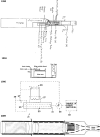Philip Morris research on precursors to the modern e-cigarette since 1990
- PMID: 27852893
- PMCID: PMC5432409
- DOI: 10.1136/tobaccocontrol-2016-053406
Philip Morris research on precursors to the modern e-cigarette since 1990
Abstract
Background: Use of electronic cigarettes (e-cigarettes) is increasing rapidly. Chinese pharmacist Hon Lik is frequently cited as inventing the modern e-cigarette in 2003. However, tobacco companies have developed electronic nicotine delivery systems since at least 1963.
Methods: We searched the University of California San Francisco Truth (formerly Legacy) Tobacco Industry Documents beginning with the terms 'electric cigarette' and 'electronic cigarettes', 'e-cigarette', 'smokeless cigarettes', 'nicotine aerosol', 'tobacco aerosol', and 'vaping' and then expanded the search using snowball sampling. We focused our analysis on Philip Morris (PM) documents discussing technology that aerosolised a nicotine solution because these devices resembled modern e-cigarettes. Over 1000 documents were reviewed; 40 were included in the final analysis.
Results: PM started developing a nicotine aerosol device in 1990 to address the health concerns and decreased social acceptability of smoking that were leading smokers to switch to nicotine replacement therapy. PM had developed a capillary aerosol generator that embodied basic e-cigarette technology in 1994, but in the mid-to-late 1990s focused on applying its aerosol technology to pharmaceutical applications because of uncertainty of how such products might affect potential Food and Drug Administration regulation of tobacco products. In 2001, PM resumed its work on a nicotine aerosol device, and in 2013, NuMark (a division of Altria, PM's parent company) released the MarkTen, a nicotine aerosol device.
Conclusions: Rather than a disruptive technology, PM developed e-cigarette technology to complement, not compete with, conventional cigarettes and evade tobacco control regulations.
Keywords: Electronic nicotine delivery devices; Tobacco industry; Tobacco industry documents.
Published by the BMJ Publishing Group Limited. For permission to use (where not already granted under a licence) please go to http://www.bmj.com/company/products-services/rights-and-licensing/.
Conflict of interest statement
Competing interests: None declared.
Figures


Similar articles
-
Explaining the discontinuation of a non-tobacco nicotine project at Philip Morris: obstacles to innovation.J Public Health Policy. 2018 May;39(2):131-142. doi: 10.1057/s41271-018-0124-1. J Public Health Policy. 2018. PMID: 29531301
-
Imitating waterpipe: Another tobacco industry attempt to create a cigarette that seems safer.Addict Behav. 2019 Apr;91:244-252. doi: 10.1016/j.addbeh.2018.10.024. Epub 2018 Oct 18. Addict Behav. 2019. PMID: 30366727
-
On the Origins of the Electronic Cigarette: British American Tobacco's Project Ariel (1962-1967).Am J Public Health. 2017 Jul;107(7):1060-1067. doi: 10.2105/AJPH.2017.303806. Epub 2017 May 18. Am J Public Health. 2017. PMID: 28520481 Free PMC article.
-
Vaping versus Smoking: A Quest for Efficacy and Safety of E-cigarette.Curr Drug Saf. 2018;13(2):92-101. doi: 10.2174/1574886313666180227110556. Curr Drug Saf. 2018. PMID: 29485005 Review.
-
Heat-not-burn tobacco products: an emerging threat to cardiovascular health.Am J Physiol Heart Circ Physiol. 2020 Dec 1;319(6):H1234-H1239. doi: 10.1152/ajpheart.00708.2020. Epub 2020 Oct 2. Am J Physiol Heart Circ Physiol. 2020. PMID: 33006919 Free PMC article. Review.
Cited by
-
The association between smoking/vaping habits and self-reported respiratory symptoms.Multidiscip Respir Med. 2024 Oct 14;19(1):976. doi: 10.5826/mrm.2024.976. Multidiscip Respir Med. 2024. PMID: 39397788 Free PMC article.
-
Electronic Cigarettes: Trends, Health Effects and Advising Patients Amid Uncertainty.J Calif Dent Assoc. 2019 Feb;47(2):85-92. J Calif Dent Assoc. 2019. PMID: 30976150 Free PMC article.
-
Willingness to Use Commercial Nicotine Gums, Lozenges, and Gummies Among Nontobacco Using Adolescents in Southern California.J Adolesc Health. 2023 Feb;72(2):277-286. doi: 10.1016/j.jadohealth.2022.09.027. Epub 2022 Dec 2. J Adolesc Health. 2023. PMID: 36470691 Free PMC article. Clinical Trial.
-
Is vaping better than smoking for cardiorespiratory and muscle function?Multidiscip Respir Med. 2020 Jul 3;15(1):674. doi: 10.4081/mrm.2020.674. eCollection 2020 Jan 28. Multidiscip Respir Med. 2020. PMID: 32670575 Free PMC article.
-
A New Ingenious Enemy: Heat-Not-Burn Products.Tob Use Insights. 2022 Feb 23;15:1179173X221076419. doi: 10.1177/1179173X221076419. eCollection 2022. Tob Use Insights. 2022. PMID: 35237081 Free PMC article.
References
-
- Boseley S. Hon Lik Invented the E-Cigarette to Quit Smoking—but Now He's a Dual User. The Guardian. 2015 Jun 9;
-
- Lik H. [24 Jul 2015];Wikipedia. 2015 https://en.wikipedia.org/wiki/Hon_Lik.
-
- Lik H. Electronic Atomization Cigarette. United States: [26 Apr 2016]. Google Patents, assignee. http://www.google.com/patents/US20070267031.
-
- Abrams DB. Promise and peril of e-cigarettes: can disruptive technology make cigarettes obsolete? JAMA. 2014;311:135–6. - PubMed
Publication types
MeSH terms
Substances
Grants and funding
LinkOut - more resources
Full Text Sources
Other Literature Sources
Medical
